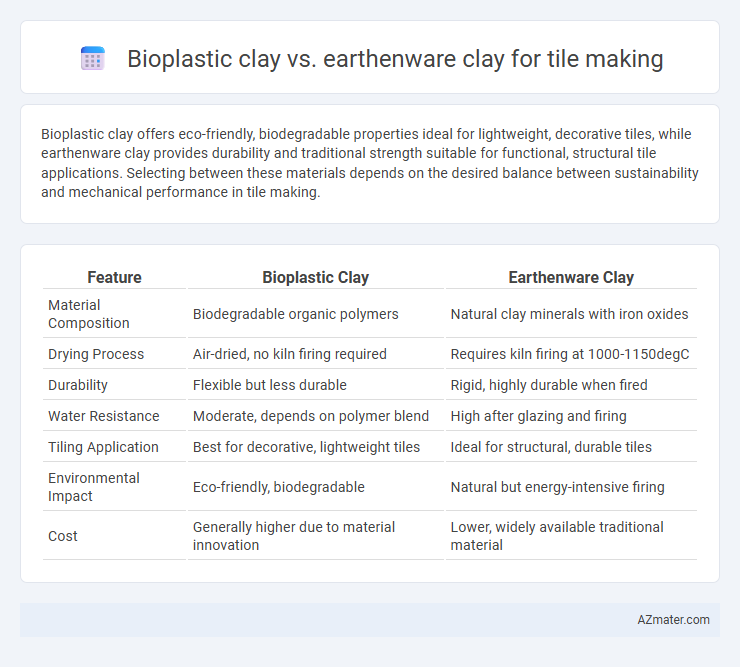Bioplastic clay offers eco-friendly, biodegradable properties ideal for lightweight, decorative tiles, while earthenware clay provides durability and traditional strength suitable for functional, structural tile applications. Selecting between these materials depends on the desired balance between sustainability and mechanical performance in tile making.
Table of Comparison
| Feature | Bioplastic Clay | Earthenware Clay |
|---|---|---|
| Material Composition | Biodegradable organic polymers | Natural clay minerals with iron oxides |
| Drying Process | Air-dried, no kiln firing required | Requires kiln firing at 1000-1150degC |
| Durability | Flexible but less durable | Rigid, highly durable when fired |
| Water Resistance | Moderate, depends on polymer blend | High after glazing and firing |
| Tiling Application | Best for decorative, lightweight tiles | Ideal for structural, durable tiles |
| Environmental Impact | Eco-friendly, biodegradable | Natural but energy-intensive firing |
| Cost | Generally higher due to material innovation | Lower, widely available traditional material |
Introduction to Bioplastic Clay and Earthenware Clay
Bioplastic clay, composed mainly of biodegradable polymers and natural fibers, offers an eco-friendly alternative to traditional materials in tile making, with characteristics such as flexibility and lightweight properties. Earthenware clay, a natural, porous material rich in iron and aluminum oxides, has been used for centuries due to its durability and ability to fire at low temperatures, resulting in strong, water-absorbent tiles. The choice between bioplastic clay and earthenware clay depends on factors like environmental impact, firing requirements, and final tile performance.
Composition Differences: Bioplastic vs Earthenware Clay
Bioplastic clay primarily consists of biodegradable polymers derived from renewable resources such as cornstarch or cellulose combined with natural clays, providing flexibility and eco-friendliness. Earthenware clay is composed mainly of natural minerals like kaolinite, quartz, and feldspar, offering porosity and sturdiness after firing. The key composition difference lies in bioplastic clay's polymer matrix enhancing plasticity and sustainability, whereas earthenware relies on traditional mineral-based components for durability and water absorption.
Sustainability and Environmental Impact
Bioplastic clay offers a sustainable alternative to traditional earthenware clay by utilizing biodegradable materials derived from renewable resources, significantly reducing plastic waste and carbon footprint in tile production. Earthenware clay, though natural, involves extensive mining and high-temperature kilning, contributing to resource depletion and greenhouse gas emissions. Choosing bioplastic clay supports eco-friendly manufacturing processes and promotes circular economy principles in the tile industry.
Workability and Handling Characteristics
Bioplastic clay offers superior workability with its lightweight, flexible texture, making it ideal for detailed tile designs and easy shaping without cracking during handling. Earthenware clay, while more traditional, tends to be denser and less pliable, requiring careful moisture control to prevent brittleness and cracks during molding and drying. The smooth consistency of bioplastic clay allows for faster manipulation and reduces the risk of deformation or breakage, enhancing efficiency in tile making.
Firing Temperatures and Methods
Bioplastic clay typically requires a low-temperature firing range between 600degC and 900degC, allowing it to retain flexibility and prevent cracking during the drying process. Earthenware clay, on the other hand, is fired at higher temperatures ranging from 1000degC to 1150degC, which vitrifies the material and creates a more durable, water-resistant tile surface. The lower firing temperature of bioplastic clay also enables quicker kiln cycles and reduces energy consumption compared to the prolonged and intense firing methods necessary for earthenware tiles.
Tile Surface Finish and Texture Comparison
Bioplastic clay offers a smooth, consistent surface finish ideal for intricate tile designs, with a non-porous texture that enhances durability and water resistance. Earthenware clay provides a more rustic, textured finish due to its natural grain and porous qualities, allowing for varied glazing effects but requiring sealing to prevent moisture absorption. The choice between bioplastic and earthenware clay significantly impacts tile surface aesthetics and functionality, influencing the final texture, finish longevity, and maintenance needs.
Durability and Strength in Finished Tiles
Bioplastic clay offers moderate durability and flexibility but typically lacks the structural strength required for high-traffic tile applications compared to earthenware clay. Earthenware clay, known for its natural composition and firing process, produces tiles with superior hardness, increased resistance to wear, and better load-bearing capacity. Consequently, earthenware tiles are more suitable for flooring and exterior uses where long-term durability and strength are critical.
Design Flexibility: Customization and Detailing
Bioplastic clay offers superior design flexibility for tile making due to its lightweight and malleable nature, allowing intricate customization and fine detailing that are difficult to achieve with traditional earthenware clay. Earthenware clay, while durable and kiln-fireable, tends to be denser and less responsive to delicate sculpting, limiting the range of textures and patterns possible. For artists prioritizing detailed, complex designs, bioplastic clay provides more versatility in shaping and refining tile elements before final curing.
Cost Considerations and Availability
Bioplastic clay generally incurs higher costs due to its synthetic components and limited production scale compared to earthenware clay, which is widely available and economically sourced from natural deposits. Earthenware clay benefits from established supply chains and local availability, reducing transportation expenses and making it a cost-effective choice for large-scale tile production. The price difference often influences manufacturers to select earthenware clay for budget-sensitive projects while reserving bioplastic clay for specialized applications that justify its premium cost.
Choosing the Right Clay for Your Tile Projects
Bioplastic clay offers flexibility and ease of shaping, making it ideal for detailed, decorative tile projects, while earthenware clay provides durability and traditional aesthetics suited for functional tiles with a rustic appeal. Earthenware clay requires higher firing temperatures and results in a porous, absorbent tile ideal for indoor use, whereas bioplastic clay often air-dries and is better for lightweight, ornamental tiles. Selecting the right clay depends on project goals, desired texture, firing method, and tile application environment.

Infographic: Bioplastic clay vs Earthenware clay for Tile Making
 azmater.com
azmater.com